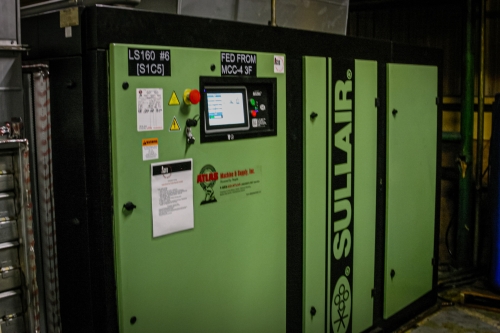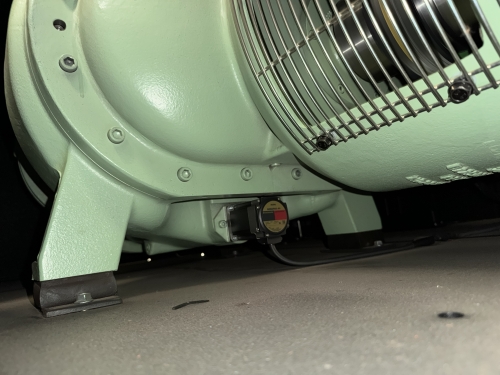Hitachi Astemo, located in Sunbury, Ohio.
Infrastructure replacements are inevitable – technology changes, as do the needs of any facility. When that replacement is also an upgrade it promises long-term, sustaining benefits that keep operations on track, reliable and efficient.
Atlas Machine & Supply Industrial Products Group Senior Vice President Andy Poplin was at the helm of one recent such upgrade with Hitachi Astemo, a major producer of automotive brake pads and shock absorbers that touts Honda as its primary customer. Poplin, a three-decade veteran of the compressed air industry, said Atlas Machine’s momentum with the customer – replacing much of its previous system with Sullair air compressors – was multipronged.
In the Industry Since 1950
Atlas Machine, established in 1907, has been a compressed air distributor since the 1950s. The firm represents Sullair compressed air system products and now maintains eight Midwestern branch locations in Kentucky, Tennessee, Ohio and Indiana, in addition to its Louisville, Kentucky, headquarters. All of its locations are ISO 9001 certified.
Hitachi Astemo, meanwhile, also has a storied history. Located in Sunbury, Ohio, it has plants across the Midwest and supports the domestic needs of Honda. Its 281,000-square-foot Ohio facility has 700 employees.

Andy Poplin, Atlas Machine & Supply Industrial Products Group Senior Vice President.
System Audit Reveals Oversupply
Hitachi Astemo’s previous compressed air system had simply served its purpose and needed an efficiency overhaul. Before working with Atlas Machine, the client had two 400-horsepower (hp) fixed speed air compressors and five 200-hp fixed speed air compressors running in load/no load control. These were spread across multiple rooms and controlled by an older model master control system. Created nearly 25 years ago, the master controller only looked at pressure measurements and switched air compressors on or off.
“They needed a little more sophistication,” Poplin said. “The client was essentially cycling air compressors more than they should and also had to have the pressure higher because of the load/no load scenario. They had to run higher pressure to maintain the target pressure for the operation of the facility.”
The aging system was also becoming expensive to maintain; between the inefficiency and maintenance costs, Hitachi Astemo’s bottom line for compressed air was ballooning.
Before any work was done, Atlas Machine performed an audit of the previous system. This week-long audit was designed to locate pain points and obstacles.
“The biggest takeaways from the audit is they were running more air compressors than they needed to based on the flow consumption,” Poplin said, noting that because of the master controller in use, the facility’s pressure was “nowhere close to being as stable as it should have been” and was running harder than required.
Post-audit, the Atlas Machine team recommended newer equipment and technology that would deliver significant improvements in energy efficiency and maintenance. What was seven air compressors became three – but those three were ready to take on even more work than ever for the client.

The LS160, one of Sullair’s newest air compressors, has an electronic spiral valve to automatically moderate air intake.
.JPG)
The display on the Sullair LS160 shows the machine’s current state and capacity.
Saving With Spiral Valve Variable Capacity Control
An eight-person Atlas Machine crew replaced three of the 200-hp air compressors with a Sullair two-stage 300-hp spiral valve rotary screw air compressor and two single-stage 160-hp spiral valve rotary screw air compressors. Four of the previous air compressors were kept on-premises as backup, although they aren’t currently being used.
Atlas Machine also installed ACES, a more advanced master controller. ACES is based on the Allen Bradley RSLogix 5000 platform, and contains algorithms to manage the facility across four different air compressor rooms.
In the end, a plant that had been run inefficiently with seven air compressors and an aging master controller was able to run efficiently with three air compressors and a state-of-the-art controller. One reason the new air compressors are more efficient is because they use Sullair’s electronic spiral valve technology, which automatically adjusts compressed air supply to meet demand.
“We made sure we had the right air compressors and control system for the job at the right time. We introduced the variable displacement machines that can help minimize the loading and unloading necessary because the machines would modulate efficiently on the spiral well, so we were able to lower the playing pressure as well,” Poplin said.
One fan of the new system is Adrian Kalmon, the senior facility technician who oversaw the project for Hitachi Astemo. “I really like the spiral valve technology and the ability to set up trim compressors,” he said. “I wasn’t able to set up a trim compressor before. Doing so look away a lot of my power peaks, which helped drop our electric costs.”
The entire project, from the audit through to the commissioning of the new system, ran from April 2023 to February 2024.
“It took a while because the installation of the air compressors was a challenge,” Poplin said. “They had these large 400-hp air compressors on a mezzanine in a plant that grew after they set the air compressors, so the logistics of getting those out and getting a new air compressor in was a challenge.”

One reason Hitachi Astemo’s new system is more efficient is because of the Sullair electronic spiral valves on its new air compressors. These work like a VSD, but instead of changing the speed of the motor, they change the length of the air end.
A Master Control That Goes Farther
The ACES master control system is a huge improvement over the client’s previous master control system. Pressure is only one of many things it examines.
“It can control the air compressors based on input information, more so than just pressure. It can do flow-based decisions, it can do location-based decisions; It's very customizable and flexible,” Poplin said. “It's unlimited in terms of what type of air compressor you control, and what type of information we can use to to make these decisions. An extremely open platform.”
Atlas Machine does something unique after installing an ACES master control system: It gives the customer the software. There are companies that don’t install a master control system unless clients sign a license agreement, Poplin shared, one that requires the client to call their distributor for even small software changes. Atlas Machine lets customers do their own programming.
“If they have programmers on staff that can handle these logistics and they want to add a pressure transmitter on the other side of the plant, they can go in and add that in without bringing us in,” Poplin said, pointing out that clients don’t need a \$5,000 service call for a \$300 part.
“The cost of the master control system verus the savings was really surprising to me,” Kalmon said. “I’ve used the calculated flow rate daily to try to pinpoint opportunities to tweak the settings so that it was more efficient, and I was able to find opportunites for efficiency gains. I looked at it one day and found I didn’t need to be running the 400-hp air compressor. I found if I changed the sequence it helped me identify the threshold where the trim compressors would take care of the changes in our load more efficiently.”
The ACES master control overview screen shows the status of the entire plant system at-a-glance. Click to enlarge.
Cost Savings of 26% for a Start
“In the future, after we fine-tune the system as those air compressors get replaced, they may not get replaced with the same horsepower,” Poplin said. “We may find that a 100-hp air compressor is something they need to trim the system properly, or maybe another 300-hp is what they need. Those are potential additional upgrades to be made, and that'll be based on the performance of the system. If there's any production changes, we want to be flexible to provide hardware that best matches how they're running.
“The efficiency gains were achieved through better control of a distributed compressed air system. It's not all concentrated in a single room, but across four air compressor rooms. Sometimes it's difficult to know which air compressor should load next, because production is different at different times of the day.”
Hitachi Astemo’s efficiency gains will turn into significant cost savings. The table below outlines the savings reported by the client since the changeover was complete. It shows a sizeable reduction in energy costs, air compressor energy costs and maintenance costs to the tune of 21.95%, 24.14% and 24.14%, respectively. Total operating costs to date have dropped from \$1,277,394 to \$941,959 with the new system a decrease of 26.25%.

Click to enlarge.
With this project complete, Atlas Machine and the Hitachi Astemo plant managers are already looking ahead to future plans. Their next project will involve separating Hitachi Astemo’s existing air knives from the compressed air system and instead using blowers to reduce energy consumption. Atlas Machine identified several undersized pipe drops with pipes half the diameter they should be. These require the compressed air system to run at a higher than needed pressure to compensate. With that corrected, the system will be able to run at a lower pressure. Finally, Atlas Machine will add cellular connections throughout the plant allowing for remote visualization and control of the system, and will even perform remote monitoring while Hitachi Astemo hires new staff.
It’s not uncommon to find up to one-quarter of compressed air consumption in a plant like this one goes to some kind of inappropriate use rather than just leaks, Poplin noted. The challenge is to find, diagnose and rectify it.
“That's our next phase with this client: to see if we can move outside of the air compressor room from the supply side into the demand side and capture even more savings,” Poplin said.
All images courtesy of Atlas Machine and Supply.
About Atlas Machine and Supply
Established in 1907, Atlas Machine & Supply, Inc. is a fourth-generation family business dedicated to providing top-notch manufacturing, repair, and rebuild services for various industrial machinery. Atlas has grown from a single facility to eight facilities in four states. For more information visit www.atlasmachine.com.
To read articles on Automotive Industry, visit www.airbestpractices.com/industries/auto.
For expert presentations, visit our Webinar Archive Section dedicated to Air Compressor Technology at www.airbestpractices.com/webinars.




